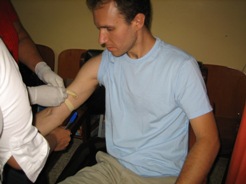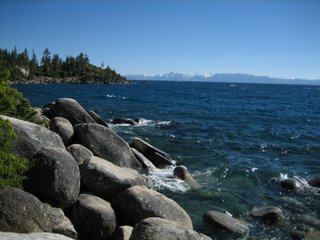Two days in Nicaragua. Where do I begin? I’ve lived in Mexico. I’ve traveled in Peru, and Ecuador. Compared with Nicaragua, these countries are rich. According to Wikipedia: Nicaragua has a GDP per capita of $867, placing it in 127th place amongst all the countries in the world, and placing it just behind Bolivia and Honduras as the poorest country in Latin America.
http://en.wikipedia.org/wiki/List_of_countries_by_GDP_(nominal)_per_capitaThey ration the water here in Managua. In the neighborhood where I’m staying, the city water only comes out of the faucet between 7pm and 7am. To cope, people fill up large basins with water at night so that they'll have water to wash with during the day. This morning I woke at 7:20am, after the water had been turned off, so I had to use a bowl and pour water over myself from a water basin that they leave in the bathtub. Same goes for using the toilet - you get one free flush once the water has been turned off - but after that flush there won't be any water to replace the water in the tank, so after that you need to dump a bucket of water in the toilet to make it flush.
There really are
no street names in Managua. I read this in the guidebook but didn't believe it until I got here and saw for myself. Instead, people give directions based on landmarks that are found in each neighborhood. People don't use the four cardinal directions, either. Instead, they say: Al Lago (North), Arriba (East), Abajo (West), y al Sur (South). For example, here’s the address of the house where I’m staying: “Barrio Campo Bruce, del Bar Los Rastros, una cuadra al sur y una cuadra arriba, frente a la casa de dos pesos. (The Campo Bruce Neighborhood, One block south of the bar “Los Rostros” and one block up, across from the house with two stories)."
Seriously, those are the directions that you would give a taxi driver and would also write on a letter if you wanted the mailman to deliver it correctly.
The house in which I'm staying is simple but they have the essentials: a refrigerator, stove, oven, microwave, TV (with cable) and a stereo covered in plastic. There’s no air conditioning. My room has a window, a double bed with a very soft mattress, a wooden dresser, a TV (with cable including HBO), and on the wall: a picture of Jesus.
Maribel lives in this one-story house with her sister Flor and her two sons: Alan (9) and William (14). Flor works at the National Laboratory at the Ministry of Health, and that is how she knows Eva Harris, the scientist at Berkeley who runs the Dengue program here in Managua.
Last night the power went out just as I was going to bed. This was problematic because the fan stopped blowing, and without fan it was HOT in my room. Then because I had trouble sleeping I woke up after 7am and had to pour myself a shower.
So far I've split my time between three different sites: The laboratory at the Ministry of Health, the Hospital Infantil Manuel de Jesus Rivera, and the Health Center Socrates Flores. In two days I've gotten a chance to meet the various doctors working on the multiple dengue projects that are all affiliated with Eva Harris at Berkeley. These include:
1)
A Cohort Study of over 1000 healthy children who live in Managua. They are followed long term and are evaluated by medical staff anually to see who develop dengue and to try to better understand risk factors and dengue transmission.
2)
A Clinical Study of all children referred to the Hospital Manuel de Jesus Rivera with suspected dengue. These children are treated and their information is all recorded electronically in a database. There is also a
Lab Component in which the viral genomes and host antibodies are analyzed by PCR and serology and are also sent to Berkeley for further analysis.
3)
A Community Health Project that sends health promoters out into the community to work on mosquito control and educate the population about how to avoid Dengue.
My involvement in this project is to help analyze data that was collected during the past year from the clinical study. Specifically, we're interested in learning how Ultrasound could better be utilized in children with Dengue.
 dengue transmission. A large group of nurses came to the health center to learn about the project and to practice drawing blood and labeling the vials. It's quite a sophisticated operation - each time they take a sample, they record the details electronically in a PDA(Palm Pilot). The whole thing is going to start in early July, and teams of nurses will go out into the community and take blood samples from all of the children who are enrolled in the study. This year, they are trying to make things easier for the nurses and they will encourage the parents to bring their children to the health center. However, those who do not come to the health center will receive a visit from the team of nurses to their houses.
dengue transmission. A large group of nurses came to the health center to learn about the project and to practice drawing blood and labeling the vials. It's quite a sophisticated operation - each time they take a sample, they record the details electronically in a PDA(Palm Pilot). The whole thing is going to start in early July, and teams of nurses will go out into the community and take blood samples from all of the children who are enrolled in the study. This year, they are trying to make things easier for the nurses and they will encourage the parents to bring their children to the health center. However, those who do not come to the health center will receive a visit from the team of nurses to their houses. used my first week of medical school when I learned how to draw blood). And when the needle entered my vein I didn't feel a thing. It was actually the most painless blood draw I've ever had.
used my first week of medical school when I learned how to draw blood). And when the needle entered my vein I didn't feel a thing. It was actually the most painless blood draw I've ever had.

